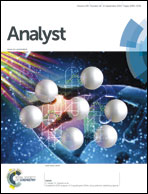High specific detection of osteopontin using a three-dimensional copolymer layer support based on electrochemical impedance spectroscopy
Abstract
Tumor marker detection is essential for the therapy efficiency of early stage tumors and the evaluation of disease progression. Osteopontin (OPN) is supposed to be closely related to several kinds of tumors. In the present study, we describe a label-free electrochemical detection of OPN based on a specific reaction between OPN and its relevant antibody. An artificial three-dimensional (3D) scaffold structure consisting of 11-mercaptoundecanoic acid/6-mercapto-1-hexanol, dextran amino and synthetic peptides was designed as a substrate for the immobilization of the antibody. This substrate was characterized using cyclic voltammetry, atomic force microscopy and Fourier transform infrared reflection spectroscopy. Antibody immobilization and OPN detection were conducted using electrochemical impedance spectroscopy (EIS). The low limit of detection was 0.17 nM. The concentration of cancer risk (5.77 nM) can be selectively detected with a high EIS signal. The fabricated 3D OPN sensor is proposed for application in clinical analysis.


 Please wait while we load your content...
Please wait while we load your content...